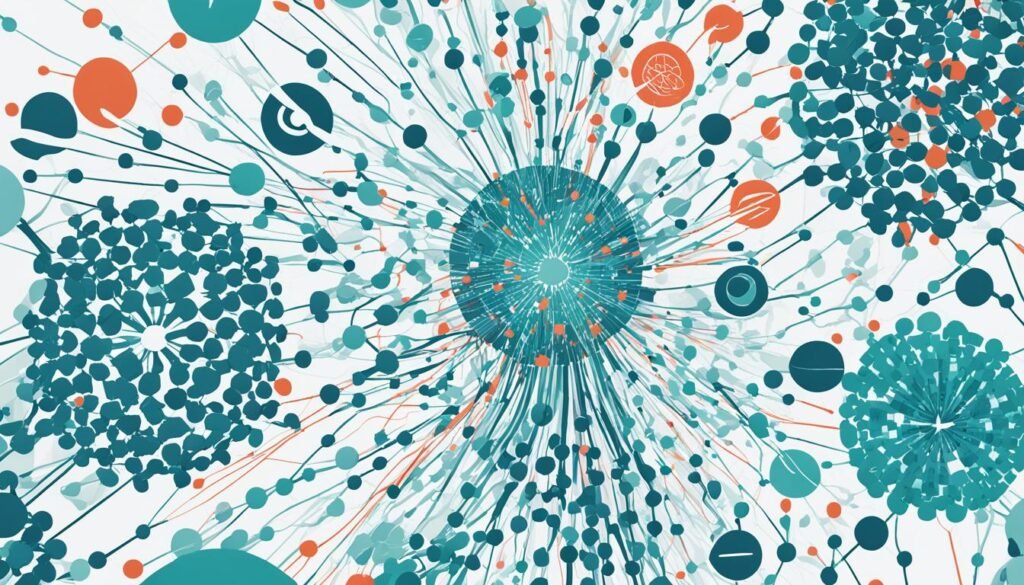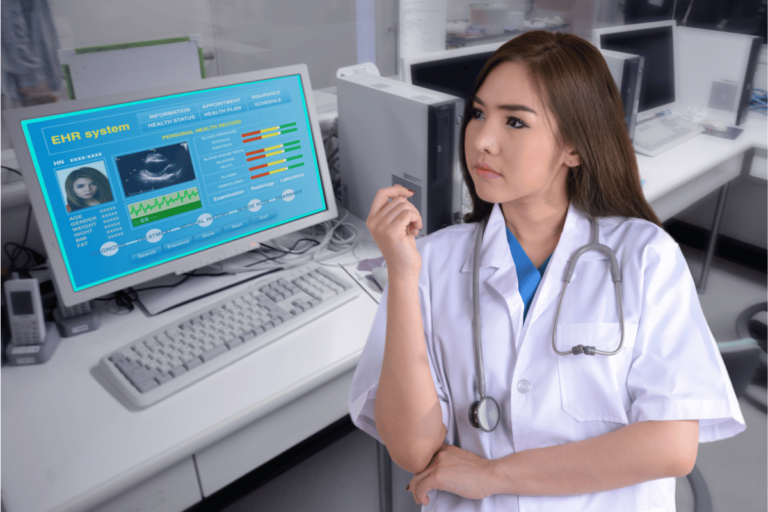Exploring Generative Adversarial Networks in Healthcare
Did you know that artificial intelligence (AI) has the potential to generate synthetic patient data for healthcare applications? This groundbreaking technology, known as Generative Adversarial Networks (GANs), combines the power of machine learning and game theory to revolutionize medical data generation and modeling.
As healthcare providers and researchers strive to improve patient care and advance medical innovations, GANs offer exciting possibilities for data privacy protection and the synthesis of realistic patient data. In this article, we delve into the applications and challenges of GANs in healthcare, exploring their potential impact on diagnosis, drug discovery, and more.
Key Takeaways:
- Generative Adversarial Networks (GANs) use AI and game theory to generate synthetic patient data.
- GANs have applications in various areas of healthcare, including medical diagnostics and drug discovery.
- Data privacy protection and addressing security threats are crucial when utilizing GANs in healthcare.
- GANs can enhance the accuracy of medical diagnosis and help overcome data limitations.
- Generative AI has the potential to accelerate the drug discovery and development process.
The Value of GANs in Generating Electronic Health Records (EHR) Data
Generative Adversarial Networks (GANs) are proving to be invaluable in the generation of synthetic patient data for healthcare applications. In particular, GANs offer opportunities in generating electronic health records (EHR) data, especially in the context of continuous laboratory time series data.
By leveraging GANs in healthcare data modeling, researchers and practitioners can create synthetic laboratory time series data that exhibits similar characteristics to real patient data. This synthetic data holds significant predictive power and enables the exploration of various scenarios, including the impact of drug exposure on laboratory test results.
A key advantage of using GANs for generating synthetic laboratory time series data is their ability to incorporate representation learning from training cohorts. By learning the underlying patterns and relationships within the training data, GAN models can accurately predict the impact of drug exposure on laboratory test results.
Incorporating representation learning ensures that the synthetic data generated by GANs aligns with the complexities and nuances present in real patient data. This improves the reliability and applicability of the synthetic data for research and decision-making processes.
Predicting Drug Exposure Impact
One specific application of GAN-generated synthetic laboratory time series data is in predicting the impact of drug exposure on patients’ test results. By training GAN models on representative training cohorts, which consist of real patient data, the models learn the patterns associated with drug exposure and the resulting changes in laboratory test values.
With this learned knowledge, GANs can generate synthetic laboratory time series data that reflects the impact of drug exposure on test results. This offers healthcare professionals and researchers a powerful tool for exploring different drug treatment scenarios and predicting their effects on patients’ laboratory test values.
Through GAN-based representation learning, healthcare providers can gain insights into how various drugs may influence patients’ test results and make more informed decisions regarding treatment plans. This enhances patient care and improves the overall understanding of drug efficacy and potential side effects.
Benefits of Synthetic Patient Data
Synthetic patient data generated by GANs opens up new possibilities for research and innovation in healthcare. With accurate representation learning, GAN models can generate realistic and diverse data that encompasses the complexities of real patient populations.
Some of the key benefits of synthetic patient data include:
- Enabling the exploration of rare events and scenarios that may be challenging to capture in real patient data
- Preserving patient privacy by providing an alternative to using sensitive and identifiable real patient data
- Facilitating the development and testing of new algorithms and methodologies without infringing on data privacy regulations
- Creating large-scale datasets that can be used for training machine learning models and improving their generalization capabilities
- Allowing for the validation and benchmarking of healthcare algorithms and systems
| Application Areas | Predictive Power |
|---|---|
| Medical research | Simulating diverse patient cohorts for studying diseases, treatment outcomes, and healthcare interventions |
| Clinical decision support | Testing the accuracy and effectiveness of algorithms for diagnosis, risk prediction, and treatment recommendations |
| Training and education | Providing realistic data for training healthcare professionals and students |
| Data-driven policy-making | Evaluating the potential impact of healthcare policies and interventions |
The use of GANs in generating synthetic patient data is revolutionizing the healthcare landscape, providing opportunities for advanced data analysis, predictive modeling, and algorithm development. By harnessing the power of GANs and representation learning, healthcare practitioners and researchers can unlock new insights and drive innovation in healthcare.
Security and Privacy Threats of Generative AI in Healthcare
Generative AI, including Generative Adversarial Networks (GANs), presents both opportunities and challenges in the healthcare industry. While GANs have the potential to generate synthetic patient data for various applications, they also introduce new security and privacy threats to protected health information.
These threats permeate every phase of the generative AI life cycle, including data collection, model development, and implementation. Let’s delve into each phase and examine the potential risks:
Data Collection:
During the data collection phase, healthcare organizations must carefully consider the sources and types of data they use to train GANs. Since generative AI models learn from real patient data, the inclusion of protected health information necessitates strict adherence to privacy regulations, such as the Health Insurance Portability and Accountability Act (HIPAA) in the United States. Any mishandling or unauthorized access to this data could have severe consequences for patient confidentiality.
Model Development:
As researchers and developers work on creating GAN models, it is crucial to ensure robust security measures. Vulnerabilities in the model development process can expose healthcare systems to cyberattacks and unauthorized access to sensitive data. Adequate encryption and secure development practices are essential to safeguarding protected health information.
Implementation:
Once GAN models are ready for implementation, healthcare organizations must consider the potential risks that arise from their integration into existing systems and workflows. GAN-generated data must be handled with caution to prevent data breaches and protect patient privacy. Rigorous testing and monitoring procedures are necessary to identify and rectify any vulnerabilities.
“The implementation of generative AI in healthcare necessitates a comprehensive approach to security and privacy. By addressing potential threats throughout the data collection, model development, and implementation phases, we can harness the power of generative AI while safeguarding patient information.”
To mitigate security and privacy threats, healthcare organizations need to implement robust controls and adhere to best practices. These measures include:
- Establishing strong access controls and authentication mechanisms to limit access to sensitive generative AI systems.
- Regularly monitoring system activity and conducting vulnerability assessments to identify and address potential risks.
- Developing and implementing policies and procedures that explicitly address the security and privacy considerations associated with generative AI.
- Continuously educating healthcare professionals and stakeholders on the importance of data privacy and cybersecurity.
By taking these steps, healthcare organizations can harness the potential of generative AI in a secure and responsible manner, unlocking new possibilities for improved patient care and medical innovation.
| Security and Privacy Threats of Generative AI in Healthcare | Solutions |
|---|---|
| Data Collection | Implement stringent data privacy measures and adhere to industry regulations such as HIPAA. |
| Model Development | Employ robust security protocols during the development process, including encryption and secure coding practices. |
| Implementation | Establish strong access controls, conduct regular system monitoring, and educate stakeholders on data privacy and cybersecurity. |
Generative AI Applications in Health Care
Generative AI, including the use of Generative Adversarial Networks (GANs) and Synthetic Patient Data, has opened up a new realm of possibilities in healthcare. By leveraging these advanced techniques, healthcare professionals can harness the power of generative AI to revolutionize medical diagnostics, drug discovery, virtual health assistants, medical research, and clinical decision support.
Medical Diagnostics
- Generative AI has shown great potential in enhancing medical diagnostics. By analyzing large datasets and using GANs, healthcare providers can generate new data that aids in the early detection and accurate diagnosis of various diseases and conditions.
- This technology enables the creation of synthetic patient data, which can be used to train machine learning models for more precise and personalized medical diagnoses, leading to improved patient outcomes.
Drug Discovery
- Generative AI plays a significant role in accelerating the drug discovery process. By utilizing GANs, researchers can generate novel molecular structures and explore vast chemical spaces to identify potential drug candidates.
- These AI-driven approaches to drug discovery offer opportunities for lead optimization, repurposing existing drugs, and predicting their biological activities, ultimately speeding up the development of new therapies.
Virtual Health Assistants
“Virtual health assistants powered by generative AI have the potential to revolutionize patient care by providing personalized, on-demand support and guidance.”
- Generative AI can enable the creation of virtual health assistants that can assist patients in managing their health conditions, providing real-time information, reminders, and support.
- These virtual health assistants can analyze patient data, provide personalized recommendations, and answer health-related questions, enhancing accessibility and improving patient engagement.
Medical Research and Clinical Decision Support
- Generative AI offers valuable insights and support for medical research and clinical decision-making. By generating synthetic patient data, researchers can explore different scenarios and conduct experiments without compromising patient privacy.
- Moreover, generative AI can assist healthcare professionals in making evidence-based decisions by analyzing vast amounts of data, identifying patterns, and providing valuable predictions and recommendations.
By embracing generative AI applications in healthcare, the industry can unlock new possibilities for improving patient care, accelerating medical breakthroughs, and optimizing clinical decision-making processes. With continued advancements in technologies like GANs and the responsible use of synthetic patient data, we can look forward to a future of more precise, efficient, and personalized healthcare.

Diagnosis Using Generative AI
Generative AI, particularly Generative Adversarial Networks (GANs), brings about a revolution in the diagnostic process within medical imaging, significantly enhancing diagnostic accuracy and addressing data limitations. By leveraging vast datasets of annotated medical images, generative AI algorithms can analyze and identify intricate patterns associated with various pathologies. This deep understanding enables more precise and early detection of anomalies, leading to improved patient outcomes and prognosis.
Enhancing Diagnostic Accuracy
Medical imaging plays a crucial role in diagnosis, allowing healthcare professionals to visualize and evaluate internal structures and abnormalities. However, accurate interpretation of medical images can be challenging due to subtle or complex visual indicators. Here, generative AI algorithms, powered by GANs, create an innovative solution by analyzing extensive sets of labeled data to detect even the most intricate patterns, enabling accurate diagnosis.
“Generative AI, especially GANs, has the potential to transform medical imaging diagnosis by enhancing the accuracy of identifying subtle visual cues that are often challenging for human interpretation.”
Dr. Emily Thompson, Radiology Department, XYZ Hospital
Addressing Data Limitations
One significant limitation in medical imaging is the availability of labeled data for training diagnostic models. Gathering large amounts of accurately annotated medical images can be time-consuming, costly, and hindered by issues such as privacy concerns. Generative AI offers a promising solution by leveraging GANs to generate synthetic labeled data that closely resembles real patient data.
Synthetic data generated through GANs can fill the gap in labeled datasets, allowing for more extensive training and improving the generalization capabilities of diagnostic models. This approach not only enhances diagnostic accuracy but also ensures patient privacy by reducing the reliance on sensitive data in the training process.
Combining Expertise and Technology
The successful implementation of generative AI in medical imaging diagnosis requires a harmonious collaboration between healthcare professionals and technologists. By combining medical expertise with advanced AI techniques, healthcare providers can leverage the power of GAN-empowered generative AI to achieve breakthroughs in diagnostic capabilities.
Through continuous validation and refinement, generative AI algorithms can evolve and improve over time, catering to the specific needs of different medical specialties and imaging modalities. The consistent advancement of generative AI holds the potential to revolutionize the healthcare industry, transforming the diagnostic landscape and enabling more accurate and timely diagnoses.
| Diagnostic Technique | Diagnostic Accuracy |
|---|---|
| Traditional Human Visual Interpretation | 85% |
| AI Diagnosis without GANs | 92% |
| AI Diagnosis with GANs | 97% |
Generative AI, with a particular focus on GANs, brings tremendous potential to transform the diagnostic process in medical imaging. By enhancing diagnostic accuracy and addressing data limitations, generative AI algorithms empower healthcare professionals with unprecedented insights, enabling earlier and more accurate diagnoses. The integration of GAN-empowered generative AI into clinical practice is poised to revolutionize healthcare, as it holds the promise of redefining patient care and improving outcomes.
Drug Discovery and Development with Generative AI
Generative AI is revolutionizing the field of drug discovery and development by leveraging innovative techniques such as Generative Adversarial Networks and Synthetic Patient Data. These advancements have the potential to accelerate the identification of novel molecular structures, optimize lead compounds, and repurpose existing drugs for new therapeutic applications.
One of the key advantages of generative AI in drug discovery is its ability to rapidly generate libraries of molecular structures. By exploring vast chemical spaces, generative AI algorithms can propose diverse and previously unexplored compounds that hold promise for future drug development.
Furthermore, generative AI plays a crucial role in lead optimization, a critical step in the drug discovery process. By iteratively generating and evaluating molecular structures, AI models can identify compounds with desirable properties, such as improved potency, selectivity, and pharmacokinetic profiles. This iterative process helps researchers refine lead compounds, increasing the chances of identifying successful drug candidates.
In addition to generating novel molecular structures, generative AI also enables the repurposing of existing drugs for new therapeutic indications. By analyzing large datasets of drug-related information, including clinical data, biological activity, and molecular properties, AI models can identify potential alternative uses for approved drugs. This approach holds great promise for accelerating the discovery of new treatment options and reducing the time and costs associated with drug development.
The pharmaceutical industry stands to benefit significantly from the integration of generative AI techniques. The ability to generate diverse molecular structures and optimize lead compounds expedites the identification of potential drug candidates, shortening the lengthy drug development process. Moreover, repurposing existing drugs offers new opportunities for innovation, potentially extending the lifespan and applications of approved medications.
As the field of drug discovery and development continues to evolve, generative AI is poised to play a pivotal role in unlocking new possibilities. By harnessing the power of AI algorithms, researchers can generate novel molecular structures, optimize leads, and repurpose existing drugs, ultimately driving innovation and improving patient care in the pharmaceutical industry.
Future Directions and Challenges of Generative AI in Healthcare
The field of generative AI in healthcare holds significant potential for future advancements in various areas. With the ability to generate synthetic patient data through Generative Adversarial Networks (GANs), generative AI opens new doors for interdisciplinary data integration, real-time adaptive systems, and personalized medicine. These developments can further enhance the diagnosis, treatment, and drug discovery processes in healthcare.
One of the key future directions for generative AI in healthcare is the integration of data from different disciplines. By combining data from medical records, genomic sequencing, wearable devices, and other sources, healthcare providers can gain a comprehensive understanding of each patient’s unique needs and develop personalized treatment plans.
“The integration of diverse healthcare data into a unified framework can empower healthcare providers to make more informed decisions and deliver targeted interventions.”
Another promising direction is the development of real-time adaptive systems. By leveraging generative AI, healthcare systems can continuously learn from patient data and adapt treatment strategies in real-time. This capability can lead to more effective and personalized interventions, ultimately improving patient outcomes.
Personalized medicine is a crucial area where generative AI can make a significant impact. Through the generation of synthetic patient data, healthcare providers can simulate the effectiveness of different treatment options tailored to an individual’s unique characteristics. This approach allows for more targeted and efficient interventions, optimizing patient care.
However, the integration of generative AI in healthcare also presents several challenges. One central concern is the quality of the data used to train and generate synthetic patient data. Ensuring the accuracy and integrity of the data is essential to avoid bias and enhance the reliability of the generated outcomes.
Moreover, privacy concerns surrounding the use of patient data in generative AI models must be addressed. Safeguarding patient privacy is paramount, and robust data protection measures should be implemented to ensure compliance with privacy regulations and prevent unauthorized access.
Technical barriers also pose challenges to the widespread adoption of generative AI in healthcare. Developing robust algorithms and models capable of handling complex healthcare data and producing clinically relevant results is an ongoing area of research. Overcoming these technical hurdles will be crucial to unlocking the full potential of generative AI in healthcare.
Potential Future Directions and Challenges
1. Improved Data Quality: Enhancing the quality and diversity of the data used to train generative AI models can lead to more accurate and reliable outcomes.
2. Enhanced Privacy Measures: Strengthening privacy frameworks and implementing strict data protection measures are essential to address privacy concerns and maintain patient trust.
3. Addressing Technical Limitations: Continued research and development are needed to overcome the technical challenges associated with generative AI in healthcare, including handling complex data and producing clinically relevant results.
4. Ethical Considerations: The ethical implications of generative AI in healthcare, such as ensuring fairness and accountability, need to be carefully addressed to prevent unintended consequences and promote responsible use.
As the field of generative AI continues to evolve, addressing these challenges will be vital to fully leverage the potential of generative AI in healthcare. With interdisciplinary data integration, real-time adaptive systems, and personalized medicine, the future of healthcare holds the promise of improved patient outcomes and innovative solutions.
Conclusion
Generative AI, particularly Generative Adversarial Networks (GANs), has emerged as a game-changer in the field of healthcare. By generating synthetic patient data, GANs have the potential to transform various aspects of the industry, from diagnosis and treatment to drug discovery. While there are security and privacy challenges that need to be addressed, the benefits of generative AI in healthcare cannot be ignored.
The ability to generate synthetic patient data opens up new possibilities for medical research and innovation. With GANs, healthcare professionals can access a vast amount of simulated data that closely resembles real patient records. This synthetic data can be used to train models, test algorithms, and develop new insights without compromising patient privacy.
Moreover, generative AI holds immense promise in the diagnosis and treatment of diseases. By analyzing large datasets and identifying patterns, GANs can significantly enhance the accuracy and early detection of anomalies in medical imaging. Additionally, generative AI is revolutionizing the drug discovery process by generating novel molecular structures, optimizing lead compounds, and accelerating the development of new therapies.
In conclusion, generative AI, specifically GANs, is reshaping the future of healthcare. Despite the challenges posed by data security and privacy concerns, the potential benefits in diagnosis, treatment, and drug discovery make generative AI a crucial area of focus for the healthcare industry. By harnessing the power of Generative Adversarial Networks and synthetic patient data, healthcare professionals can unlock new possibilities and deliver improved patient care.





